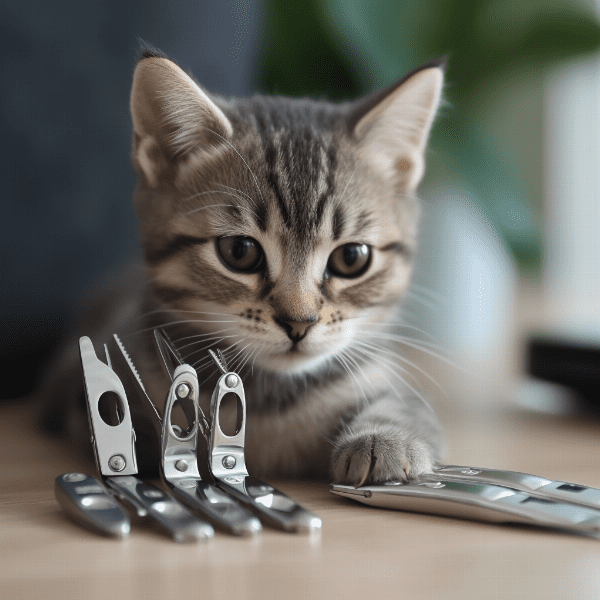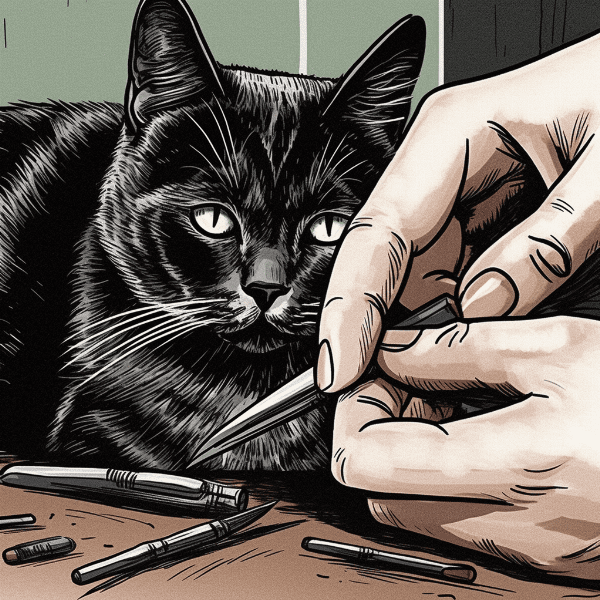Table of Contents
- Why Proper Restraint is Important for Cat Nail Clipping
- Types of Cat Restraints for Nail Clipping
- Top 5 Cat Restraints for Easy Nail Clipping
- Features to Look for in a Cat Restraint for Nail Clipping
- Tips for Using a Cat Restraint Safely and Effectively
- Alternatives to Restraint for Cat Nail Clipping
- How to Train Your Cat to Accept Nail Clipping and Restraint
- Understanding Your Cat’s Nail Anatomy and Care
- Conclusion: Finding the Best Cat Restraint for Your Feline Friend
Why Proper Restraint is Important for Cat Nail Clipping
Trimming your cat’s nails is an essential part of their grooming routine, and it’s important to do it safely and effectively. One of the most critical components of safe nail clipping is using proper restraint. Restraint helps keep your cat still and calm during the clipping process, reducing the risk of injury to both you and your furry friend.
Prevent Injury to Yourself and Your Cat
Without proper restraint, you risk injury to yourself and your cat during the nail clipping process. Cats can become easily frightened and agitated when they feel trapped, and they may lash out with their claws or bite. By using a restraint, you can keep your cat still and prevent them from injuring you or themselves.
Avoid Stress and Anxiety
Restraint can also help reduce your cat’s stress and anxiety during nail clipping. When a cat feels secure and supported, they’re less likely to become agitated or afraid. A good restraint should provide enough support to help your cat feel safe and relaxed during the grooming process.
Ensure Accurate Nail Clipping
Using a restraint can also help ensure accurate nail clipping. When a cat is moving around or struggling, it can be difficult to get a clean cut. With a good restraint, you can keep your cat’s paw steady and get a precise cut, reducing the risk of accidentally cutting the quick.
Conclusion
Overall, proper restraint is essential for safe and effective nail clipping for your feline friend. By using a restraint, you can prevent injury, reduce stress and anxiety, and ensure accurate nail clipping. In the next section, we’ll discuss the different types of cat restraints available for nail clipping.
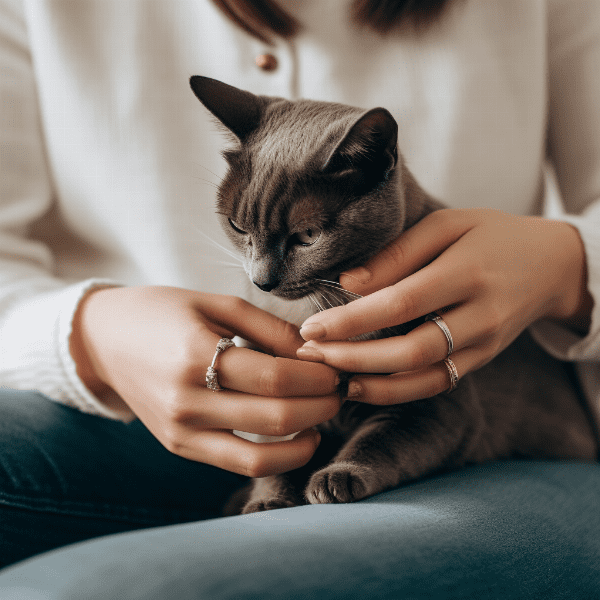
Types of Cat Restraints for Nail Clipping
Now that we’ve discussed why proper restraint is important during Cat nail clipping, let’s explore the different types of restraints available. Each type of restraint has its pros and cons, and choosing the right one for your cat will depend on their personality, size, and level of comfort with being handled.
Towels and Blankets
One of the most common and straightforward types of restraint is a towel or blanket. Wrapping your cat in a towel or blanket can help keep them still and calm during nail clipping. To use a towel or blanket, start by placing it on a flat surface and then place your cat on top. Wrap the towel snugly around your cat, leaving their head exposed, and hold them firmly but gently.
Cat Restraint Bags
Another type of restraint that is becoming increasingly popular is a cat restraint bag. These bags are specially designed to hold cats securely during grooming, vet visits, or other procedures. Restraint bags are made from durable materials and have openings for your cat’s head, tail, and legs, allowing you to access their paws for nail clipping.
Harnesses
If your cat is used to wearing a harness, you can use it as a restraint during nail clipping. A harness can be a great option for cats who are more active or less comfortable with being wrapped in a towel or placed in a bag. Simply attach the leash to a secure object to keep your cat in place, and then trim their nails.
Cat Muzzles
For cats who are prone to biting or are more aggressive, a cat muzzle may be necessary. A muzzle is designed to fit over your cat’s mouth and prevent them from biting during grooming or other procedures. However, it’s important to use a muzzle correctly and remove it immediately if your cat shows signs of distress or discomfort.

Top 5 Cat Restraints for Easy Nail Clipping
If you’re looking for a cat restraint for easy nail clipping, there are several great options on the market. Here are five of the best cat restraints for safe and effective nail clipping:
1. Cat Sack Restraint Bag
The Cat Sack Restraint Bag is a popular choice among cat owners for its ease of use and effectiveness. Made from high-quality materials, this bag is designed to hold cats securely during grooming or vet visits. It has multiple openings for your cat’s head, legs, and tail, making it easy to access their paws for nail clipping.
2. K&H Pet Products EZ Mount Window Bed Kitty Sill
The K&H Pet Products EZ Mount Window Bed Kitty Sill is a great option for cats who are comfortable in harnesses. This window-mounted bed attaches securely to any window and provides a comfortable, secure spot for your cat to relax while you clip their nails.
3. Petneces Cat Grooming Bag
The Petneces Cat Grooming Bag is another popular option for cat owners. This bag is made from durable, scratch-resistant materials and has multiple openings for your cat’s paws, tail, and head. It’s designed to fit cats of all sizes and is easy to use and clean.
4. PetSafe Happy Ride Cat Harness and Bungee Leash
The PetSafe Happy Ride Cat Harness and Bungee Leash is a great option for cats who are comfortable in harnesses. This harness is designed to be secure and comfortable, and the bungee leash allows your cat some freedom of movement while still keeping them safely restrained during nail clipping.
5. K&H Pet Products Hangin’ Cat Condo
The K&H Pet Products Hangin’ Cat Condo is a unique option for cat owners who want a versatile restraint that can also serve as a cozy hideaway for their cat. This hanging condo attaches securely to any door and has multiple levels and openings for your cat to climb and explore. When it’s time for nail clipping, simply secure your cat in the condo and access their paws through the openings.
Conclusion
There are several excellent cat restraints available for easy nail clipping. When choosing a restraint, consider your cat’s personality and comfort level, as well as the effectiveness and ease of use of the restraint. In the next section, we’ll discuss the features to look for in a cat restraint for nail clipping.
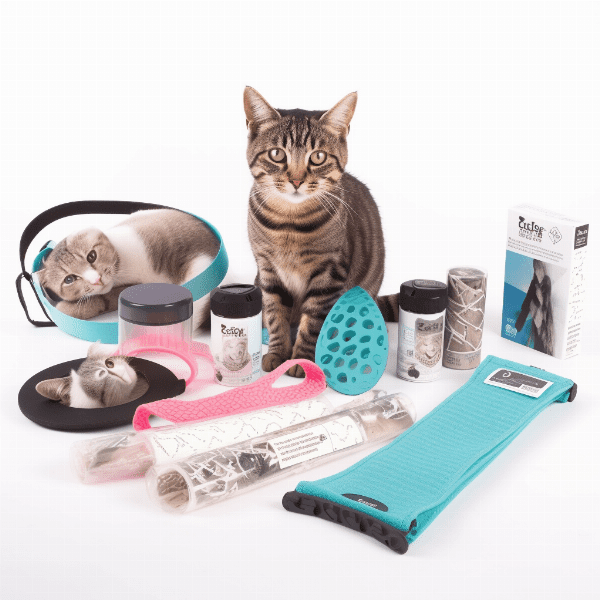
Features to Look for in a Cat Restraint for Nail Clipping
When choosing a cat restraint for nail clipping, there are several features to consider. A good cat restraint should be safe, comfortable, and effective in keeping your cat still and calm during the grooming process. Here are some features to look for in a cat restraint for nail clipping:
Material
The material of the restraint should be durable, easy to clean, and comfortable for your cat. Look for a material that is resistant to scratches and bites, and that can withstand repeated use. It’s also essential to choose a material that won’t cause your cat discomfort or irritation.
Size
Choosing the right size of restraint is crucial for your cat’s safety and comfort. A restraint that is too big may not be effective in keeping your cat still, while a restraint that is too small may be uncomfortable and cause your cat to feel anxious. Measure your cat’s size and choose a restraint that fits snugly but comfortably.
Accessibility
A good cat restraint should allow you to access your cat’s paws easily and effectively for nail clipping. Look for restraints with multiple openings for your cat’s paws, tail, and head, as these will make the process of clipping your cat’s nails easier and more comfortable for both you and your cat.
Ease of Use
A cat restraint that is easy to use will make the process of clipping your cat’s nails less stressful for both you and your cat. Look for restraints that are easy to put on and take off and that don’t require a lot of effort to use. This will help ensure that you can use the restraint safely and effectively without causing additional stress to your cat.
Conclusion
Choosing the right cat restraint for nail clipping can help make the process easier, safer, and less stressful for both you and your cat. When choosing a restraint, consider the material, size, accessibility, and ease of use to ensure that it’s safe and effective. In the next section, we’ll discuss tips for using a cat restraint safely and effectively during nail clipping.
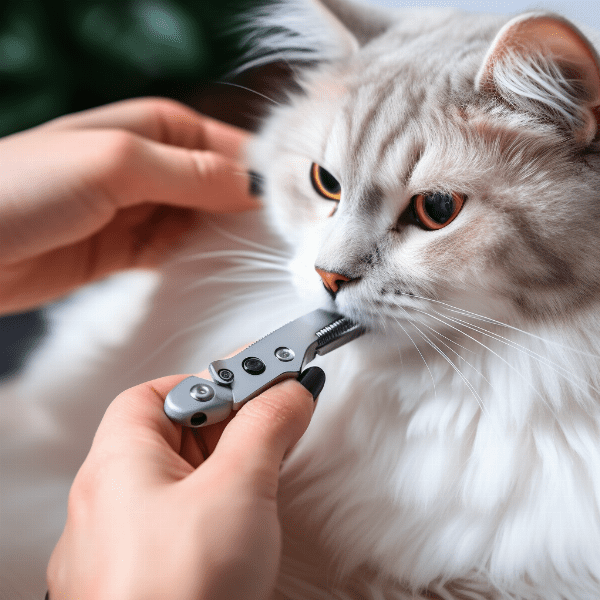
Tips for Using a Cat Restraint Safely and Effectively
Using a cat restraint for nail clipping can help keep both you and your cat safe and comfortable. However, it’s important to use the restraint correctly to ensure that it’s effective and doesn’t cause any harm to your cat. Here are some tips for using a cat restraint safely and effectively:
Practice Patience and Calmness
Using a cat restraint can be stressful for both you and your cat. It’s essential to practice patience and calmness during the process to avoid causing additional stress or anxiety for your cat. Speak to your cat in a calm and soothing tone, and take breaks if either you or your cat become overwhelmed.
Follow the Instructions
Different types of cat restraints may have specific instructions for use. It’s important to read and follow these instructions carefully to ensure that the restraint is used safely and effectively. For example, some restraints may require you to secure your cat to a specific object or surface, while others may need to be adjusted for your cat’s size.
Keep the Restraint Secure
It’s important to keep the restraint secure during nail clipping to ensure that your cat doesn’t escape or injure themselves. Make sure that the restraint is adjusted properly and that your cat is comfortable and secure within it. If your cat is struggling or trying to escape, stop the process and try again later.
Reward Your Cat
After each nail clipping session, reward your cat with treats, praise, or playtime. This will help create a positive association with the restraint and make future nail clipping sessions easier and less stressful.
Conclusion
Using a cat restraint for nail clipping can be a safe and effective way to keep your cat still and comfortable during grooming. By introducing the restraint gradually, practicing patience and calmness, following the instructions, keeping the restraint secure, and rewarding your cat, you can help ensure that the process is safe and stress-free for both you and your feline friend. In the next section, we’ll explore alternatives to restraint for cat nail clipping.

Alternatives to Restraint for Cat Nail Clipping
While cat restraints can be effective for nail clipping, some cats may not tolerate being restrained. Fortunately, there are alternative methods for cat nail clipping that may work better for some cats. Here are some alternatives to restraint for cat nail clipping:
Positive Reinforcement Training
Positive reinforcement training is a method of training that uses rewards and praise to encourage good behavior. With this method, you can teach your cat to associate nail clipping with positive experiences, making the process less stressful and more enjoyable for them. Start by offering your cat treats or playtime during nail clipping, and gradually increase the amount of time you spend clipping their nails.
Scratch Pads and Posts
Scratch pads and posts can help keep your cat’s nails trimmed naturally while providing a fun and stimulating activity for them. Place scratch pads and posts around your home, and encourage your cat to use them regularly. This can help keep their nails short and reduce the need for nail clipping.
Professional Grooming Services
If your cat is particularly anxious or difficult to handle, you may want to consider professional grooming services. A professional groomer can safely and effectively clip your cat’s nails, reducing the risk of injury to both you and your cat. Additionally, professional groomers have experience handling difficult or anxious cats, and can help keep the process stress-free and safe for everyone involved.
Conclusion
While cat restraints can be effective for nail clipping, they may not be suitable for all cats. Alternatives such as positive reinforcement training, scratch pads and posts, and professional grooming services can be a great option for cats who are uncomfortable with being restrained. It’s important to find a method that works for your cat and to approach nail clipping with patience and care to ensure their safety and comfort. In the next section, we’ll answer some frequently asked questions about cat restraints for nail clipping.

How to Train Your Cat to Accept Nail Clipping and Restraint
Training your cat to accept nail clipping and restraint can take time and patience, but it’s worth the effort to ensure their safety and comfort during grooming. Here are some steps you can take to train your cat to accept nail clipping and restraint:
Step 1: Start Slowly
Begin by getting your cat used to having their paws touched. Gently touch and hold their paws for a few seconds at a time, and reward them with treats and praise. Repeat this process daily, gradually increasing the amount of time you spend touching their paws.
Step 2: Introduce the Clippers
Once your cat is comfortable with having their paws touched, introduce them to the clippers. Allow them to sniff and investigate the clippers, and reward them for any positive interactions. Repeat this process daily, gradually getting your cat used to the clippers.
Step 3: Introduce the Restraint
Once your cat is comfortable with the clippers, you can begin introducing the restraint. Start by showing your cat the restraint and allowing them to investigate it on their own terms. Gradually introduce the restraint by placing it near your cat and allowing them to approach it.
Step 4: Practice Using the Restraint
Once your cat is comfortable with the restraint, practice using it for short periods of time. Begin by simply placing your cat in the restraint without clipping their nails. Reward them for positive interactions and gradually increase the amount of time they spend in the restraint.
Step 5: Clip Your Cat’s Nails
Once your cat is comfortable with the restraint, you can begin clipping their nails. Start slowly, clipping just one or two nails at a time, and gradually work your way up to a full nail clipping session. Reward your cat for positive interactions throughout the process.
Conclusion
Training your cat to accept nail clipping and restraint takes time and patience, but it can help ensure their safety and comfort during grooming. Start slowly, getting your cat used to having their paws touched and gradually introducing the clippers and restraint. Practice using the restraint and gradually work up to a full nail clipping session. By approaching the process with patience and care, you can help ensure a positive experience for both you and your feline friend.

Understanding Your Cat’s Nail Anatomy and Care
Understanding your cat’s nail anatomy and care can help you keep their nails healthy and prevent potential problems. Here are some important things to know about your cat’s nails:
Nail Anatomy
A cat’s nail is made up of several parts, including the nail bed, quick, and claw. The nail bed is the pink part of the nail and contains blood vessels and nerves. The quick is the part of the nail that contains blood vessels and nerves and can be seen as a pink or red line inside the nail. The claw is the hard outer shell of the nail.
Nail Care
Regular nail care is important for your cat’s health and wellbeing. Overgrown nails can cause discomfort and pain, and can even lead to infections or other problems. Check your cat’s nails regularly and trim them as needed. It’s important to use proper nail clippers designed specifically for cats and to avoid cutting into the quick, which can be painful and cause bleeding.
Scratching Behavior
Scratching is a natural behavior for cats and helps them maintain healthy nails and stretch their muscles. Provide your cat with scratching posts and pads to encourage this behavior and prevent them from scratching furniture or other objects. It’s also important to provide your cat with plenty of exercise and playtime to keep their muscles and joints healthy.
Common Problems
Some common problems with cat nails include overgrown nails, ingrown nails, and broken nails. Overgrown nails can be trimmed with proper nail clippers, while ingrown nails may require veterinary attention. Broken nails can be painful and may require treatment from a veterinarian.
Conclusion
Understanding your cat’s nail anatomy and care can help you keep their nails healthy and prevent potential problems. Regular nail care, providing scratching posts and pads, and providing your cat with plenty of exercise and playtime can all help maintain healthy nails and prevent issues. If you notice any problems with your cat’s nails, consult with your veterinarian for appropriate treatment.

Conclusion: Finding the Best Cat Restraint for Your Feline Friend
Choosing the Best cat restraint for nail clipping can help make the process easier, safer, and less stressful for both you and your cat. Whether you opt for a traditional restraint or an alternative method, it’s important to approach nail clipping with patience, care, and a focus on your cat’s safety and comfort.
Tips for Choosing a Cat Restraint
When choosing a cat restraint, look for a durable, comfortable material and the right size for your cat. Consider accessibility and ease of use to ensure that the restraint is effective and easy to handle. Additionally, consider the specific features of each type of restraint to determine which will work best for your cat.
Other Methods for Nail Clipping
If your cat is not comfortable with being restrained, there are alternative methods for nail clipping, such as positive reinforcement training, scratch pads and posts, and professional grooming services. By finding the method that works best for your cat, you can help ensure a safe and stress-free experience.
Understanding Your Cat’s Nail Anatomy and Care
Understanding your cat’s nail anatomy and care is important for maintaining their health and wellbeing. Regular nail care, providing scratching posts and pads, and monitoring for potential problems can all help prevent issues and keep your cat healthy and happy.
Conclusion
Overall, finding the best cat restraint for nail clipping and understanding your cat’s nail anatomy and care can help ensure a positive experience for both you and your feline friend. By taking the time to choose the right restraint, practice safe and effective techniques, and prioritize your cat’s safety and comfort, you can help ensure a successful nail clipping session every time.


